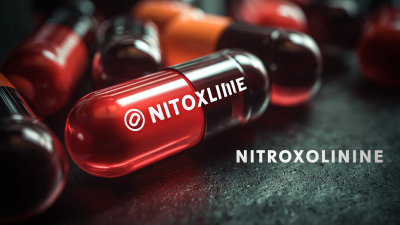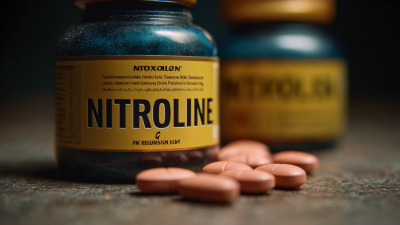Leave Your Message
In recent years, the pharmaceutical landscape has witnessed an increasing interest in Nitroxoline, a quinolone derivative, known for its antimicrobial properties and potential therapeutic applications beyond its established use in urinary tract infections. According to a report by the Global Market Insights, the global antimicrobial drugs market is anticipated to reach USD 70 billion by 2026, underscoring the significance of innovative agents like Nitroxoline. As researchers delve into Nitroxoline Clinical Studies, the drug's efficacy against various bacterial strains and its mechanism of action are coming under scrutiny, paving the way for its possible incorporation into broader treatment regimens.

This shift not only highlights Nitroxoline's relevance in addressing antibiotic resistance—a major concern in modern medicine—but also its implications for global buyers looking to invest in effective, clinically validated therapies.
Nitroxoline, initially introduced in the 1960s as an antibiotic, has evolved into a significant compound in medical research. Originally utilized for its antimicrobial properties, it proved effective against various gram-positive and gram-negative bacteria, particularly in treating urinary tract infections. Over the years, subsequent studies revealed its potential in other therapeutic areas, such as its anticancer properties, prompting interest from the global medical community. This historical backdrop provides an intriguing lens through which we can understand the compound's current applications and emerging significance in clinical trials.
Tip: For those involved in clinical research, it's essential to keep abreast of the historical advancements of compounds like Nitroxoline. Understanding its past can illuminate its present and future potential in treatment protocols.
The repurposing of Nitroxoline highlights a growing trend within pharmacology: the retargeting of existing drugs. As researchers explore its mechanisms, the implications for global buyers become clear. With rising interest in affordable, effective treatment options, Nitroxoline stands out for its cost-effectiveness and established safety profile.
Tip: Buyers should consider not only the effectiveness of a drug but also its history and established use cases, which can provide assurance of its reliability in clinical settings.
Nitroxoline, an antibiotic primarily used to treat urinary tract infections, operates through several mechanisms that enhance its efficacy in clinical applications. One of its key actions involves the chelation of metal ions, which disrupts bacterial enzyme activity. This interference is critical as it impairs the bacteria's ability to utilize essential nutrients, thereby stunting their growth and leading to eventual cell death.
Furthermore, nitroxoline demonstrates a unique ability to disrupt bacterial biofilms, complex structures that protect pathogens from both the immune system and antibiotics, allowing for a more effective treatment response in difficult-to-treat infections.
Additionally, recent studies suggest that nitroxoline may exhibit anti-inflammatory properties, which could contribute to its utility in managing infections beyond the urinary tract. By modulating inflammatory pathways, nitroxoline not only combats bacterial proliferation but also mitigates tissue damage caused by inflammatory responses. This dual action makes it a potential candidate for broader therapeutic applications, prompting global buyers to consider nitroxoline not just as a standalone treatment but also as part of combination therapies in clinical research.
Nitroxoline, initially utilized as an antimicrobial agent, is now being explored for its potential applications in treating infectious diseases and cancer. Recent studies highlight its role as a metal-chelating agent, which may enhance therapeutic outcomes in various clinical settings. The compound has demonstrated efficacy against certain resistant strains of bacteria, suggesting that it could provide alternative treatment options where conventional antibiotics fail. Furthermore, its ability to bind metal ions positions nitroxoline as a promising candidate in oncology, where metal metabolism plays a pivotal role in cancer progression.
Current clinical applications of nitroxoline are expanding beyond its historical use. Reports indicate that the drug's pharmacokinetic properties allow for effective absorption and distribution within the body when administered in specific dosages, optimizing its role in infection management. In a review conducted by the Department of Medical Microbiology and Infectious Diseases, it was highlighted that nitroxoline's action on urinary tract infections (UTIs) remains significant, particularly in cases caused by multidrug-resistant pathogens. As clinical research continues to illuminate its multifaceted benefits, nitroxoline stands out as a valuable agent in modern healthcare strategies.
| Clinical Application | Mechanism of Action | Dosage Form | Indications | Side Effects |
|---|---|---|---|---|
| Urinary Tract Infections (UTIs) | Inhibits bacterial growth by interfering with DNA synthesis | Oral tablets | Empirical treatment of uncomplicated UTIs | Nausea, headache, allergic reactions |
| Prostatitis | Halts bacterial proliferation | Oral tablets | Treatment of bacterial prostatitis | GI disturbances, dizziness |
| Bacterial Infections | Interference with metabolic processes in bacteria | Oral tablets | Various bacterial infections including resistant strains | Allergic responses, skin rash |
| Antimicrobial Therapy | Targeted action against Gram-positive and Gram-negative bacteria | Oral tablets | Broad-spectrum antimicrobial for various infections | Rare cases of nephrotoxicity |
| Prevention of Post-Surgical Infections | Reduces risk by effective antimicrobial activity | Oral tablets | Pre-surgical prophylaxis | Mild GI upset, skin allergies |
The global demand for Nitroxoline, an antimicrobial agent primarily used in urinary tract infections, has shown significant trends influenced by changing healthcare needs and rising awareness of antibiotic resistance. According to a recent market analysis report by Grand View Research, the Nitroxoline market is expected to expand at a compound annual growth rate (CAGR) of over 6.5% from 2023 to 2030. This increase is attributed to the growing incidence of urinary infections and the quest for alternatives to conventional antibiotics, which are becoming less effective.
 As for supply trends, the availability of Nitroxoline varies across regions, with Europe accounting for the largest market share. The demand from developing countries is also rising, driven by the need to combat prevalent bacterial infections. Manufacturers are focusing on scaling production to meet this global demand, while ensuring compliance with regulatory standards set by organizations like the FDA and EMA.
As for supply trends, the availability of Nitroxoline varies across regions, with Europe accounting for the largest market share. The demand from developing countries is also rising, driven by the need to combat prevalent bacterial infections. Manufacturers are focusing on scaling production to meet this global demand, while ensuring compliance with regulatory standards set by organizations like the FDA and EMA.
Tips for buyers:
The future prospects of Nitroxoline in global health initiatives are promising, particularly in the realm of antimicrobial treatment and infection control. With the rising prevalence of antibiotic resistance, Nitroxoline's unique properties as a broad-spectrum antibacterial agent make it an attractive candidate for further clinical research. Its potential to combat urinary tract infections and other bacterial infections could provide a more effective option for patients who have limited responses to conventional antibiotics. As healthcare professionals and researchers explore its applications, Nitroxoline's role may expand beyond its current uses, offering new solutions in the fight against resistant strains of bacteria.

Moreover, Nitroxoline could significantly impact global health initiatives by improving accessibility to effective treatments in low-resource settings. As nations grapple with healthcare disparities, the introduction of cost-effective therapeutics like Nitroxoline could enhance treatment protocols and outcomes for vulnerable populations. Collaboration between pharmaceutical companies, government agencies, and international health organizations will be crucial in ensuring that the benefits of this drug reach those who need it most. Emphasizing research and education around Nitroxoline will not only bolster its clinical applications but also position it as a key player in global strategies aimed at combating infectious diseases.






